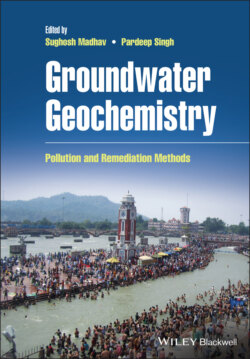Читать книгу Groundwater Geochemistry - Группа авторов - Страница 117
4.4.1 Impact of Heavy Metal Pollution in Groundwater: Some Case Studies
ОглавлениеGroundwater resources are world's largest freshwater sources. They provide adequate water supply for domestic, agricultural and industrial practices. Uniquely, their role in sustainability of ecosystems is immensely vital. Therefore, the sustainability of groundwater quality and quantity itself is very important for the above‐mentioned phenomena. However, owing to various anthropogenic activities in the recent past, groundwater resources are undergoing catastrophic depletion and deterioration. Particularly, the overexploitation and continuous groundwater pollution works in a synergic fashion and cause non‐availability of groundwater and making it unfit for any use. Here, in this section we are putting forward few global examples that illustrates the devastating impacts of polluted groundwater on smaller and bigger scales.
Boateng et al. have studied the extent of heavy metal contamination in Oti landfill site, Kumasi, and further evaluated the effect of this contamination on human health. Through the standard methods and procedures for the examination of water and wastewater, authors reported that the concentration of many metals like Pb, Cd, Fe, and Cr was above the acceptable limits as set by the WHO for drinking water. It was reported that only the concentration of Zn and Cu was within the permissible limit. Further, it was revealed that this high level of heavy metal contamination in groundwaters of Oti has grave health consequences and water needs to be pretreated before its consumption (Boateng et al. 2019).
In a recent report, a meta‐analysis on the impact of consumption of polluted groundwater on health of children was executed in 10 developing countries including India. The research shows that blood of the children from these countries have relatively higher levels of heavy metals than normal cases and this problem is only attributed to the polluted groundwater by the researchers Horton et al. (2013); (Singaraja et al. 2015; Mohankumar et al. 2016). The groundwater pollution problem is a very serious concern across the world, however, the situation in developing economies, especially heavily populated ones, is very critical. In these countries, industrial growth and agricultural practices are rapidly increasing and consequently, offering more and complex hurdles in the sustainable management of groundwater resources. For instance, the Kurichi Industrial Cluster near Coimbatore city does not have agricultural activities and waste dumping nearby it, however, it has given a comprehensive Environmental Pollution Index (CEPI) score of 58.75 by the Central Pollution Control Board (CPCB, India) in 2009, which implies that the water was critically polluted (Action plan for critically polluted area, Tamilnadu Pollution Control Board, 2010, www.tnpcb.gov.in/pdf/Action_plan_cbe.PDF). This is because of the release of unchecked wastewater streams of local industries in groundwater. This transformed the local groundwater and nearby groundwater tables into highly toxic systems. The groundwater sources are not suitable for domestic and agricultural practices. Further, many ill effects on human health, soil fertility, bioaccumulation, and biomagnification of the toxic heavy metals are spreading with a higher pace in the region. To mitigate the issues, the local authorities had imposed stronger legislations on the industries and wastewater treatment plants were commissioned in many industries.
Many such studies are now published by many research groups, NGOs (nongovernmental organizations), environmentalists, and local governments. However, the real scenario is even worse than that reported in these studies, especially in the areas where infrastructure is not that strong. Moreover, many examples of the hazardous effects of consumption of groundwater contaminated with heavy metals are presented throughout the chapter.
Therefore, a comprehensive review on such aspects and illustration of the true picture of the problem is required for making the sustainable policies and strategies to propagate the sustainability of groundwater resources and their uses.
